CAMP CHESTERFIELD TIMELINE
1883: Dr. J.W. and Mrs. Mary Westerfield first entertained the idea of founding a Spiritualist association in Indiana after visiting the Frazer’s Grove Spiritualist Camp near Vicksburg, Michigan on July 17, 1883, and meeting several other Hoosiers who had traveled to Michigan to attend services.
1883-1886: Dr. Westerfield worked diligently to contact Hoosier Spiritualists all over the state to garner widespread interest to form an association and build a camp dedicated to Hoosier Spiritualists.
1886: Dr. Westerfield called a mass meeting in Anderson, Indiana with around 200 Hoosier Spiritualists in attendance. The group met regularly at a space above Dr. Westerfield’s pharmacy in downtown Anderson, Indiana.
1887 (November 5): The officers and members adopted a Constitution and Bylaws, forming a legally sanctioned association as an incorporated body, allowing the organization to perform transactions on behalf of the association.
1888 (October 22): The group was officially incorporated as the Indiana Association of Spiritualists (IAOS), under the direction of the newly elected president, Dr. J.W. Westerfield.
1889 (September 26): At the annual convention for the association, Dr. L.M. Blackledge was elected as the association’s third president.
1890: The annual convention, held as a church picnic, elected Dr. J.W. Westerfield as the fourth president of the IAOS. The event took place on the riverside property in Chesterfield, Indiana of Carroll and Emily Bronnenberg.
1891: Without formal purchase of the property being completed, a “gentleman’s agreement” had been made with workers hired to clear part of the land to make space for the annual camp meeting in 1891. A large tent-auditorium was erected to seat 500 attendees.
1892: On August 12, the thirty-four acres of land were purchased in the amount of $3,225 from Carroll and Emily Bronnenberg. Both the Westerfields and Bronnenbergs made sizable donations to the IAOS to enable the land’s purchase.
1895-1900: The fifth president of the association, George W. Parkinson, served the association from 1895-1898. Many mediums began the custom of “advertising” their gifts around this time.
1903: The large tent-auditorium was replaced by a wood-framed auditorium, equipped with a free-standing stage at one end which allowed for sermons and mediums to give “platform” messages to the congregation.
1909: Rev. Mable Riffle became Secretary of the IAOS and continued in this capacity for the rest of her life.
1914: The “Sunflower Hotel” was built at a construction cost of $6,887, with seventy rooms available to guests.
1916: A flower garden and fountain was built on the site of the Old Boarding House after it was moved and attached to the Sunflower Hotel as an addition to the newly built hotel.
1918: A new dining hall was built that featured stand-alone brick ovens to bake bread and pastries.
1922: The Lily Hotel was built as a twin hotel of the Sunflower Hotel, each facing one another as guests entered the front gate to the camp.
1922-1924: The Sunflower Hotel was expanded with the addition of forty rooms; the old Lodging House was moved and attached to the back in 1916, in the west section of the existing hotel.
1930: The Garden of Prayer was built into the side of a small hill in the center of the grounds from river rock found in the White River that borders the property.
1936: The “Lyceum Building” was constructed for the educational arm of the IAOS. The name was later changed to the “Chapel in the Woods,” and this structure hosts platform message services, galas, church services, weddings, and funerals.
1940: The Trail of Religions statue grouping was constructed to honor religious figures from the world’s great religions; in addition, a memorial to Native American Indians and their religious beliefs was built on the grounds.
1945: The construction of the Western Hotel, in “American roadside architecture” was authorized and later built as a modern hotel.
1950: A Native American Totem Pole was donated to the IAOS by Bruno Cieslak, and it was erected next to the Native American Memorial.
1953-1954: The second auditorium, built in 1903, was razed to build the “Cathedral of the Woods,” which was dedicated on June 26, 1954.
1958: The Hett Art Gallery and Museum was constructed to house the many archived documents, Spiritualist artifacts, and spiritual works of art related to the IAOS and history of Camp Chesterfield.
1974: The Julia Urbanic Memorial statue of Jesus Christ was dedicated beside the Administration Building.
1996: Arsonists set fire to th Lily Hotel, and it was completely lost.
1998: The Tree of Life Bookstore and Gift Shop was renovated and rebuilt in the space vacated by the Lily Hotel after the 1996 fire.
1998: The United States Department of the Interior, in conjunction with the “National Park Services,” designated Camp Chesterfield as an “historic district,” listing it officially on the National Register of Historic Places.
2013: The Friends of Camp Chesterfield Foundation (FCCF) was formed as a non-profit organization to promote and encourage the preservation of Camp Chesterfield’s historic buildings and landscape displays and architecture.
FOUNDER/GROUP HISTORY
Since multitudes of people began to flock to Spiritualist mediums in the nineteenth century, it was only within a few years of the Fox sisters’ discovery in 1848 that regular church meetings gradually organized around “camps” where visitors could attend services and have personal readings by the mediums. One such Spiritualist Camp is located in the small town of Chesterfield, Indiana. Since 1886, the Spiritualist church camp of the Indiana Association of Spiritualists (IAOS) (affectionately called “Camp Chesterfield” by the locals) has been offering visitors spiritual reprieve and comfort.
Hoosier Spiritualists initially were forced to travel out of state in order to visit a Spiritualist Camp during the high season. Many Hoosiers went west, some went east, but a goodly number from the Anderson, Indiana area travelled north to Michigan. After visiting a Spiritualist camp in Michigan, John and Mary Ellen Bussel-Westerfield of Muncie, Indiana, decided that Indiana needed its own association and set out to find a suitable location for a homegrown Spiritualist camp.
A popular Spiritualist gathering that took place every summer at Frazer’s Grove Camp, near Vicksburg, Michigan, was the closest and easiest Spiritualist camp in proximity to Indiana. Indeed, well before the Spiritualist movement had taken root in Indiana so firmly, the Westerfields were interested in esoteric subjects and were firmly established in the intelligentsia movement in the Anderson area, hosting gatherings above Dr. Westerfield’s pharmacy in downtown Anderson. It was in the year 1883, however, when the Westerfields were on one of their trips to Vicksburg, Michigan, that the idea to found a Spiritualist association in Indiana was first proposed:
There were six people in attendance from Indiana and these, including Mrs. Annie M. Stewart, the internationally known Pence Hall Materialization medium of Terre Haute [Indiana], were Samuel Connors, County Commissioner of Vigo County; Ben Hayden and wife of Clinton County, and the Westerfields of Madison County. All had gravitated together between services for a little Indiana-style socializing and were happily listening as Dr. Westerfield, resplendent in shaped grey mustache and beard, declared: “If the Spiritualists of Michigan can successfully operate three or four camp meetings, why can’t Indiana sustain at least one camp of her own, if properly located near the central part of the state, where all her people could attend?” (Harrison et al 1986:10)
This was the beginning of the formation of what is now the Indiana Association of Spiritualists. It took Dr. Westerfield three years to get organized and to contact interested Spiritualists, but by the autumn of 1886, he was ready to call a mass meeting of Hoosier Spiritualists to begin the process of securing a camp for the about to be formed association. Over two hundred interested people attended that first meeting, electing a president (Dr. George Hilligoss); a secretary (Caroline Hilligoss, wife of George); and a treasurer (Carroll Bronnenberg). (Harrison et al 1986:11).
The Bronnenberg Family (Carroll, Henry, and Fred) were a part of the association from its formation in 1886. The landowning Bronnenbergs were an early pioneer family to the area and became an integral and important component in the formation of the association and in donating the funds necessary to purchase the land that would become Camp Chesterfield.
After meeting for more than three years in Westerfield’s hall above his pharmacy, it was on November 5, 1887 that a constitution and by-laws were prepared to incorporate their informal gatherings into an officially sanctioned society, “legally qualified to transact all business pertaining to the organization and religion of Spiritualism” (Harrison et al 1986:14). The annual convention of 1890 was held as a church picnic on property owned by Carroll and Emily Bronnenberg near the banks of the White River, which became the future spiritual home of the IAOS, nicknamed “Camp Chesterfield.” “Dr. and Mary Westerfield were instrumental in the ongoing negotiations for the grounds, and on August 12, 1892, the thirty-four acres of land was purchased from Carroll and Emily Bronnenburg for $3,225. The Westerfields and Carroll Bronnenberg each gave large donations to the Association enabling this purchase” (Harrison et al 1986:16).
Initially, Camp Chesterfield was only a tent-based church similar to the old-style revival tents that itinerant ministers used to preach to the masses across the Midwest. By 1900, the camp had begun to take shape with a number of buildings being erected around the main grounds: medium cottages, séance rooms, a dining hall, an auditorium, a lodging house, a small store called “The Bazaar”, along with more makeshift structures in the form of tents and shanties. By the Tenth Annual Camp Meeting, Camp Chesterfield was no longer merely a campground but a thriving Spiritualist community. Hoosiers from all over the state were flocking to this quaint little retreat, causing many growing pains for the leaders of the IAOS as horses needed to be stabled, visitors needed places to stay and eat, and mediums needed housing. The camp grew exponentially in the years after it was founded, and by 1909 it was about to welcome a new person who would take charge and develop its structures and religious programs even more. She strengthened the association and Camp Chesterfield to become a leader in Spiritualism for not only Indiana, but for the entire United States and beyond.
Singularly, the most important person to walk through the gates of Camp Chesterfield in the early 1900s was an unassuming school teacher from nearby Anderson, Indiana. The impact this woman would have on Camp Chesterfield and the Indiana Association of 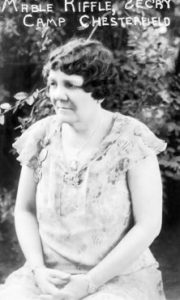 Spiritualists, as well as the religion of Spiritualism as a whole, is nothing short of prodigious. From around 1909 until her death in 1961, Reverend Mable Riffle [Image at right] steered Camp Chesterfield with a strong hand as Secretary of the association. Rev. Riffle’s resounding mantra during her long years of service to the IAOS and Spiritualism was a simple question: Is it good for Camp? (Richey 2009). This was her response to any proposal, idea or change that the Board of Trustees, mediums, residents, or members would endeavor to implement. If the answer were “no,” then it would go no further. Her lifelong dedication to the “good” of Camp Chesterfield is evident in the huge growth that occurred under her watchful guidance.
Spiritualists, as well as the religion of Spiritualism as a whole, is nothing short of prodigious. From around 1909 until her death in 1961, Reverend Mable Riffle [Image at right] steered Camp Chesterfield with a strong hand as Secretary of the association. Rev. Riffle’s resounding mantra during her long years of service to the IAOS and Spiritualism was a simple question: Is it good for Camp? (Richey 2009). This was her response to any proposal, idea or change that the Board of Trustees, mediums, residents, or members would endeavor to implement. If the answer were “no,” then it would go no further. Her lifelong dedication to the “good” of Camp Chesterfield is evident in the huge growth that occurred under her watchful guidance.
Thanks to the work and dedication of this longtime secretary of the association, Camp Chesterfield expanded its physical components tremendously during her tenure, replacing dilapidated wooden buildings with modern structures that would endure into the current era. Under her tutelage, Camp Chesterfield constructed a stone cathedral, a quaint chapel in the woods, a modern cafeteria, hotels, and a museum with an extensive collection of Spiritualist artifacts including the cornerstone of the original Fox Cottage and locks of hair from the Fox Sisters. Upon Mable Riffle’s death in 1961, the association and Camp Chesterfield continued to thrive largely due to her hard work and dedication over the prior half century of service to the IAOS, Camp Chesterfield and Spiritualism. Interestingly, Mable Riffle never became president, preferring to work as secretary, an office that allowed her to not only run the day-to-day functions of the camp, but also to be privy to all that was occurring within its gates.
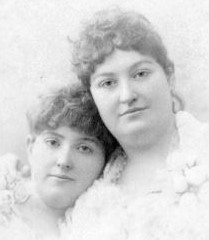
Two other women who were quite renowned and who are now a part of the history of Camp Chesterfield were the “Bangs Sisters,” [Image at right] Elizabeth S. and May E. Bangs, of Chicago, Illinois who were frequently featured as guest mediums at Camp Chesterfield in the early 1900s. They often summered at Camp Chesterfield during the high season, living in the cottage located at 421 Grandview Drive.
The spiritual gift for which the Bangs Sisters became most famous was what is referred to as “precipitated” portraits, spirit portraits that appear seemingly without the aid of human intervention other than being physically present for the spirit to access and draw energy from the medium(s). The paintings were reportedly done on large canvas-mountings that were held on either side by the sisters. At some point during the sitting, without any paints or brushes being used, a faint image would begin to appear, gradually becoming more prominent and darker.
Dr. Daugherty attended the Science Church of Spiritualism in 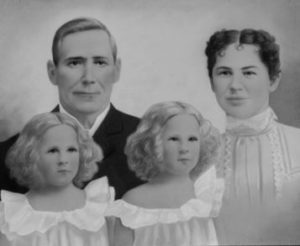 Richmond, Indiana in the early 1920’s. He sat for the portrait of his wife, Lizzie, and she appeared. He asked why the twins, Mary and Christina, could not come, and they then appeared. [Image at right] Dr. Daughtery was not in spirit, but was sitting for the portrait.
Richmond, Indiana in the early 1920’s. He sat for the portrait of his wife, Lizzie, and she appeared. He asked why the twins, Mary and Christina, could not come, and they then appeared. [Image at right] Dr. Daughtery was not in spirit, but was sitting for the portrait.
The paintings, of which twenty-five are on public display in the Hett Art Gallery and Museum at Camp Chesterfield, Indiana, are remarkable in their detail and quality. The actual source of the images remains disputed, of course. True believers point to the firsthand accounts of eye-witnesses as proof that the paintings were not produced by human hands, but by some unseen spiritual force that painted the images of deceased loved ones for those sitters on the earth plane as a “spiritual gift” to assist them in their grief and loss. Skeptics offer evidence of trickery by the sisters. That debate notwithstanding, the precipitated portraits that are on 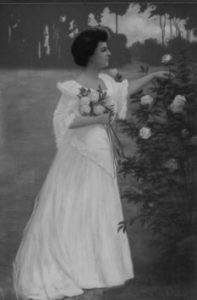 display represent a significant and tangible glimpse into the history of Spiritualism and precipitated spirit art, [Image at right] of which Camp Chesterfield and the Indiana Association of Spiritualists have the singular duty as the primary custodians to preserve and protect these works as it is an unparalleled collection and is the world’s largest repository of precipitated spirit art.
display represent a significant and tangible glimpse into the history of Spiritualism and precipitated spirit art, [Image at right] of which Camp Chesterfield and the Indiana Association of Spiritualists have the singular duty as the primary custodians to preserve and protect these works as it is an unparalleled collection and is the world’s largest repository of precipitated spirit art.
Historically, after major wars, Spiritualism tended to rise in stature and scope, prompting bereaved relatives to search for some sort of sign or message from those whom they lost so tragically. These anguished times were actually heady days for the IAOS and Camp Chesterfield, with crowds of people clamoring to make contact with loved ones in Spirit. Camp Chesterfield continues to flourish as a Spiritualist camp, church, and seminary. Generations of Hoosiers have walked through its gates, basking in its meditative peace and spiritual harmony it offers. Although there are no mediums today like the Bangs Sisters who are able to do the extraordinary mediumistic gifts of precipitated spirit art, mediums at Camp Chesterfield still do offer those who visit personal confirmation of the continuity of life, and they abundantly dispense hope to those who are seeking solace and comfort that their loved ones are indeed well and in a better place.
Since 1886, the IAOS and Camp Chesterfield has served as a beacon for those seeking spiritual guidance, and it is likely that this Indiana religious landmark will continue on. With each generation of Hoosiers who come through its gates, continuing to seek their own personal spiritual truth and wishing to make contact with those who have departed from this earth plane, Camp Chesterfield will serve those in need of spiritual guidance and healing.
The seminary arm of the association has become well-known and quite renowned, attracting students from all over the United States, and beyond, for the study of Spiritualism, New Age Spirituality, and Metaphysics. Being one of a few Spiritualist organizations that offer formal certification in mediumship, healing, and the ministry sets Camp Chesterfield apart from other similar associations which primarily rely upon affiliated churches to train and develop mediums and offer classes toward ordination. Camp Chesterfield has gained a reputation for educating, training and developing Spiritualist mediums that are sought after for their intuitive abilities by both Spiritualists and non-Spiritualists alike. Camp Chesterfield‘s mediums are endearingly referred to as “name callers” because when a spirit comes through, it is most often by name, which offers confirmation to the person receiving the message.
In 2013, a non-profit foundation was founded to assist the IAOS in renovating and preserving Camp Chesterfield’s historic buildings and its unique landscape architecture and displays. The Friends of Camp Chesterfield Foundation (FCCF) was formed to assist the Camp board with raising funds and in applying for grants as a non-profit that are normally not available to a religious-based organization or church. The mission of the FCCF is solely to preserve and restore the aging structures and displays, and to educate the public about the importance of Camp Chesterfield as an historical and cultural asset unique to the State of Indiana and even in a broader sense to that of the United States.
Today, Camp Chesterfield is a flourishing Spiritualist community equipped with a full-service cafeteria, a spacious cathedral, two hotels, a modern bookstore and library, an art gallery and museum of Spiritualist artifacts, and a quaint little chapel in the woods. In addition, it allegedly boasts the first fire-proof building in the state of Indiana, (Hattaway M. 2008) a nostalgic hotel called the “Western” that allows visitors to step back in time upon entering its front doors. During the summer, visitors sit in the old-style gliders on the front 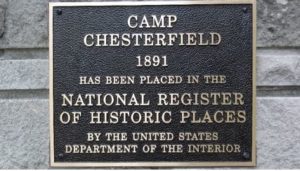 porch chatting and exchanging messages they received from loved ones. Camp Chesterfield is historically significant for Indiana, being listed on the National Park Service’s “National Register of Historic Places” as a historic district. [Image at right] Camp Chesterfield has served as a spiritual center of light for generations of Hoosiers, contributing greatly to the religious fabric that makes up Indiana’s unique religious history.
porch chatting and exchanging messages they received from loved ones. Camp Chesterfield is historically significant for Indiana, being listed on the National Park Service’s “National Register of Historic Places” as a historic district. [Image at right] Camp Chesterfield has served as a spiritual center of light for generations of Hoosiers, contributing greatly to the religious fabric that makes up Indiana’s unique religious history.
DOCTRINES/BELIEFS
The overriding, primary focus of Spiritualism is to prove the continuity of life after death through spirit communication. Spiritualism has historically shunned the idea of “dogma,” as represented in mainstream Christian religions, and quite proudly from its beginning, considered itself to be the “unchurch” of belief systems. Today, in comparison to New Age philosophy, however, it does seem quite churchified, which is actually the opposite of what it initially intended to be in the early years of the movement. Many older Spiritualists do not like to be classified into the “New Age” category because they feel they are quite “Old Age” in their beliefs and practices.
Traditionally, Spiritualists (due to the negative attitude many people and society had towards the movement in its early years, and still do to a certain extent today) often had a “Sunday” church they attended regularly, but would supplement their spiritual needs with visits to a medium to receive a reading or to attend a séance; attend church and message services; or visit a Spiritualist camp during the high season. This hesitation to be dedicated Spiritualists was a form of self-preservation from ridicule that they might endure from family, friends, and neighbors. Hence, many attended services at their mainstream church on Sunday morning, but would then attend a Spiritualist service in the afternoon. To this day, Camp Chesterfield’s main Sunday service begins in the afternoon in order to accommodate those who may have other services they 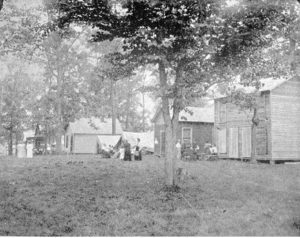 want or need to attend in the morning. This is indeed a throwback to the time when such an arrangement was needed and necessary in order to accommodate its worshipers.
want or need to attend in the morning. This is indeed a throwback to the time when such an arrangement was needed and necessary in order to accommodate its worshipers.
Spiritualists, as a rule, do accept the truths and teachings from all religious traditions as long as these beliefs come from a place filled with light and love, and offer the adherent hope and compassion. Camp Chesterfield throughout its long history [Image at right] has had a very pronounced “Christian” influence as Christian iconography can be found sprinkled about its grounds in landscape displays, as well as in the buildings in the forms of crosses, hymnals, and even statues of Jesus that are prominently displayed and placed throughout its grounds. Christian Spiritualists, like Mable Riffle, were instrumental in building Camp Chesterfield, and as the majority of these early mediums converted to Spiritualism from a 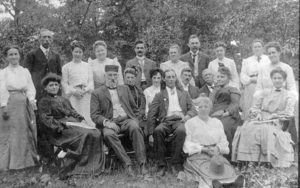 more mainstream Christian tradition, they brought with them vestiges and customs that were a part of their religious upbringings and belief systems. [Image at right]
more mainstream Christian tradition, they brought with them vestiges and customs that were a part of their religious upbringings and belief systems. [Image at right]
In addition to its Christian influence, however, Camp Chesterfield also celebrates the world’s major religions with a unique display called the “Trail of Religions” that contains the busts of ancient religious leaders in a semi-circle, all looking toward the center where a bust of Jesus can be found, with his eyes looking upward toward the heavens. This coalescing of religious traditions is what makes Spiritualism unique, and is what makes Camp Chesterfield so sacred and special to believers: Throughout their long history as a movement and a camp, both Spiritualism and Camp Chesterfield have welcomed people of all faiths and traditions to come together to commune with those who have passed to the other side of the veil through spirit communication.
Camp Chesterfield’s members and residents come from many varied religious traditions: A Methodist minister, an Episcopalian priest, a Jewish mystic, a Buddhist, a Catholic nun, a Native American, a Pagan, to name a few. It is impossible to compartmentalize the members of Camp Chesterfield into a specific category of worshiper or into one belief system.
Even though it is often said that Spiritualism has no set doctrine or dogma that regulates its belief system or adherents, there is a set of principles that have been put forth for believers to follow as Spiritualists. The following are the IAOS “Declaration of Principles” that guide its members in their Spiritualist beliefs (Camp Chesterfield website n.d.):
We believe in Infinite Intelligence.
We believe that the phenomena of nature, both physical and spiritual, are the expression of Infinite Intelligence.
We affirm that a correct understanding of such expression and living in accordance therewith constitute true religion.
We affirm that the existence and personal identity of the individual continue after the change called death.
We affirm that communication with the so-called dead is a fact, scientifically proven by the phenomena of Spiritualism.
We believe that the highest morality is contained in the Golden Rule: “Whatsoever ye would that others should do unto you, do ye also unto them.”
We affirm the moral responsibility of the individual, and that we make our own happiness or unhappiness as we obey or disobey nature’s physical and spiritual laws.
We affirm that the doorway to reformation is never closed against any human soul here or hereafter.
We affirm that the precepts of prophecy and healing contained in the Bible and all sacred writings of the world are Divine attributes proven through mediumship.
These principles are used as a general guide for living that Spiritualists follow in their daily and spiritual lives, allowing them to follow their own form of spirituality. These principles may be drawn from an organized set of tenets and dogma from another religion, or from a personal set of beliefs that conform to the basic ideals of Spiritualism.
The IAOS also offers the following definitions to clarify the meaning of Spiritualism as an association (Camp Chesterfield website n.d.)
Spiritualism is the science, philosophy, and religion of continuous life based upon the demonstrated fact of communication by means of mediumship with those who live in the spirit world.
Spiritualist is one who believes, as part of his or her religion, in communication between this and the spirit world by means of mediumship, and who endeavors to mold his or her character and conduct in accordance with the highest teachings derived from such communion.
Medium is one whose organism is sensitive to vibrations from the spirit world, and through whose instrumentality, intelligences in that world are able to convey messages and produce the phenomena of Spiritualism.
Spiritual Healer is one who is able to impart vital, curative force to pathologic conditions through inherent power or through mediumship.
Camp Chesterfield’s education arm currently has two distinct paths: 1) The study of Spiritualism and mediumship to develop one’s gift of mediumship to become a certified medium, and for those who feel a calling, to study towards ordination as a Spiritualist minister; 2) to study Metaphysics formally to receive certificates for various levels of study.
RITUALS/PRACTICES
Camp Chesterfield is a year-round facility, allowing members and visitors to attend church services, “gala” message services, psychic fairs, and/or individual readings and group séances by appointment with resident mediums throughout the year. From June through September, the camp functions in what is called “high season,” which is the historical and traditional time of the year when more activities are planned and offered for visitors. The annual convention of the IAOS is held in early August where members gather to hear the President’s report, various committee reports, as well as voting on any constitutional amendments that have been brought to the convention and the election of board members whose position is up for election.
The annual “Summer Workshop Series” offers weekly presentations on a variety of spiritual and metaphysical topics by guest presenters and resident mediums and members. These workshops begin in June and are scheduled through October. The premier event for the season every year is the annual “SpiritFest” that is scheduled on the third weekend of September. Readers, vendors, and other spiritually-related organizations descend upon the grounds for two full days of activities, including the popular “Kidsville” for children, hourly lectures, message services, tours of the grounds, and a variety of food options.
Several “weeklong” seminaries are scheduled throughout the year, with a number of “mini-seminaries” offered on long weekends. These are geared toward students who are wanting to become certified healers, mediums, and ordained ministers. In addition, a number of mediums have been designated as “development” teachers and they have weekly or bi-weekly meetings with students in their homes to assist students in their mediumship development. Student services that are regularly scheduled during weeklong seminaries allow students to give sermons and platform messages as a practicum.
Weekly healing, church, and message services are scheduled year-round. The church and message services feature “platform” work by the mediums where those in attendance can receive messages from loved ones in spirit. These are open to the public and church services have a collection plate that is passed around; and the message services ask for a specified “love” donation at the door upon entering the sanctuary. Nearly all of the mediums who offer their gifts on the platform are certified Camp Chesterfield mediums, a large portion being residents of the grounds, with occasional “guest” mediums offering messages and/or sermons. These guests are required to be certified mediums or ordained Spiritualist ministers from an area church or another Spiritualist association or camp.
A Camp Chesterfield church service resembles closely a church service one would experience at any number of protestant Christian churches, with the exception being that after a short sermon, two or three mediums will offer messages to those in attendance from loved ones in spirit. Some of the mediums rely on pure clairvoyance, clairaudience, or clairsentience to receive messages, while others will offer precipitated “flame messages” (where the medium uses a candle and card to allow Spirit to precipitate an image onto the card. The medium then interprets it to the person receiving it while offering a message from spirit; usually this is a loved one, but this can also be from a Spirit guide of the person. Other mediums will use tools to assist them in their message work, like Tarot card reading, Spirit Art, Flower Messages, or Psychometry. These all are combined with clairvoyance or clairaudience to offer a message to the person.
At any given time throughout the year, a number of other activities, events, and workshops are scheduled ranging from intensive mediumship development seminars, women’s and men’s retreats, holiday celebrations, full moon ceremonies, guest speakers, and séance and healing circles. Each year the types and scope of events vary with some of them being offered yearly and regularly, while others are offered exclusively for that event. Many mediums and ministers at Camp Chesterfield often say “we’ll leave the light on for you” after a scheduled service or event. Visitors to the grounds do find that no two visits to Camp Chesterfield are ever the same; so much is offered that anyone can find something new and interesting to participate in when visiting the grounds.
ORGANIZATION/LEADERSHIP
The Indiana Association of Spiritualists (IAOS), the custodian of historic Camp Chesterfield has been active since 1886. The board of trustees is currently made of up of twelve members with ten being leaseholders and two as non-leaseholders from the general membership. There is a President, Vice-President, Secretary, Treasurer, and then regular board members. No board position is paid, with all duties being done voluntarily. There are a number of paid employees on the grounds to assist in the administration office, bookstore, cafeteria, and hotel.
To become a member of the IAOS, a prospective member must apply to the board by filling out a membership application and then must be formally accepted to join. There is a yearly membership fee, and once a person is certified there are yearly fees that must be paid in accordance to the level of certification that he/she has attained. In addition, residents must pay a yearly lot fee, but each leaseholder is responsible for the property around his/her cottage or abode.
In order to qualify to be a leaseholder, a person must be a member in good standing of the IAOS, and it is preferred that the person be able to offer something in the form of “service” to the IAOS and to Camp Chesterfield. This usually is in the form of being able to do platform mediumship, teach classes, or to assist in some aspect of the running of the association and camp. The leaseholder then may purchase a home by working out the details of the sale privately with the current owner. The lease is for ninety-nine years; meaning that the leaseholder only owns the structure, with the land being owned solely by the association. Should a resident transition into Spirit, the person’s heirs do not automatically have the right to reside in the home. If the person is a member of the IAOS, then he/she can apply for a lease. If not, then the family member is required to sell the home to a member who is approved to have a lease on the grounds.
In order to become a working medium on the grounds, the medium must go before the board to be tested for the gift(s) he/she would like to demonstrate publicly at services or to be offered from their homes on the grounds. Resident mediums who wish to offer development classes to aspiring mediums must get board approval. Each phase of mediumship must then be approved by the board (for example, a medium may be allowed to offer regular development classes, but if he/she would wish to offer “trance-mediumship” classes, then separate approval would be necessary to do so). The testing by the board is to ensure that the medium’s gift is sufficiently developed in terms of accuracy to be worthy of being a certified “Chesterfield Medium.”
ISSUES/CHALLENGES
As with many denominations that experienced a crisis in membership, the 1990s and 2000s witnessed a drop in overall church attendance at Camp Chesterfield. There was also a decrease in monetary donations and fewer students opting to matriculate into the educational programs that offered certification as healers, mediums and associate ministers, as well as eventual ordination into the Spiritualist ministry. This trend has changed in recent years with higher attendance and an increase in students wishing to develop their mediumship.
People often initially seek out a Spiritualist medium due to a tragedy with which they need to find solace and closure. Once this occurs, many adherents move on to other spiritual endeavors or return to their mainstream church from which they initially came. Such temporary interest, of course, does not supply the camp with dedicated members who will continue to support the church and its activities.
Spiritualism historically is not a missionary or evangelical-based religion, instead believing that “those who are meant to come will find it on their own.” Spiritualism also has been very slow and hesitant to accept modern technology in spreading its message, preferring to take a spiritual attitude toward such endeavors. Spiritualism‘s peer religions, Mormonism and Christian Science, have been much more successful in maintaining their religions by proselytizing and conforming more rapidly to technological changes in modern society.
Camp Chesterfield continues to exist due in large part to the original vision of its founding members and the commitment of its longtime secretary, Mable Riffle. Historically, Spiritualism has regularly endured times of great prosperity and times of near extinction. Camp Chesterfield, as it modernizes its appeal to a new generation of spiritual seekers, will continue to offer confirmation of life after death to those who come through its gates. Although the number of visitors and members may not be as large as it was during its heyday, as interest in the paranormal and communication with the “dead” heightens, so may interest in this “Old Age” religion.
IMAGES
Image #1: Rev. Mable Riffle, long-time Secretary of the Indiana Association of Spiritualists. Photo courtesy of Camp Chesterfield’s Hett Art Gallery and Museum Archives.
Image #2: The Bangs Sisters, Lizzie and May, circa 1900. Photo courtesy of Camp Chesterfield’s Hett Art Gallery and Museum Archives. .
Image #3: Spirit painting of Dr. Daugherty sitting for a portrait. His wire and twin children appeared in the painting. Photo courtesy of Camp Chesterfield’s Hett Art Gallery and Museum Archives.
Image #4: A life-sized precipitation spirit portrait of Mrs. Emily Carson for her husband during a sitting with the Bangs Sisters in 1894. Photo courtesy of Camp Chesterfield’s Hett Art Gallery and Museum Archives.
Image #5: National Register of Historic Places plaque dedication, June 2015. Photo courtesy of the author.
Image #6: An early photograph of the mediums’ shanties with visitors’ tents. Photo courtesy of Camp Chesterfield’s Hett Art Gallery and Museum Archives.
Image #7: An early camp meeting at Camp Chesterfield circa 1890s. Photo courtesy of Camp Chesterfield’s Hett Art Gallery and Museum Archives.
REFERENCES **
** Unless otherwise noted, the material in this profile is drawn from Todd J. Leonard Historic Camp Chesterfield and the Indiana Association of Spiritualists (IAOS)—A Spiritual Center of Light. Sunflower Series. Chesterfield, IN: Camp Chesterfield Publishing.
Camp Chesterfield website. n.d. Accessed from www.campchesterfield.net on 3 December 2018.
Harrison, P., et al. 1986. Chesterfield Lives! Spiritualist Camp—1886-1986: Our First Hundred Years. Chesterfield, Indiana: Camp Chesterfield Press.
Hattaway, M. 2008. Personal Conversation. Camp Chesterfield, Indiana.
Leonard, Todd J. 2018. Historic Camp Chesterfield and the Indiana Association of Spiritualists (IAOS)—A Spiritual Center of Light. Sunflower Series. Chesterfield, IN: Camp Chesterfield Publishing.
Richey, L. 2009. Personal Interview. Indiana Association of Spiritualists (IAOS) Headquarters. Historic Camp Chesterfield, Chesterfield, Indiana.
SUPPLEMENTARY RESOURCES
Austin, B.F. 1924. The Religion of Abraham Lincoln. Los Angeles: The Austin Publishing Company.
Buckley, William R. 2011. Precipitated Spirit Paintings, the Bangs Sisters, and Camp Chesterfield. Moorseville, IN: Mooresville Public Library Indiana Room. Retrieved on February 12, 2014 at http://mplindianaroom.blogspot.jp/2011/01/bangs-sisters-and-precipitated-spirit.html.
Buescher, John B. 2004. The Other Side of Salvation: Spiritualism and the Nineteenth-Century Experience. Boston: Skinner House Books.
Bundy, John C. 1888. “The Angel of Death Enters the Bangs Household.” Religio-Philosophical Journal, April 14. Accessed from http://spirithistory.iapsop.com/spirit_materialization. html on 15 June 2019.
Cadwallader, Mary E. 1917. Hydesville in History. Lily Dale, NY: National Spiritualist Association of Churches (NSAC).
Camp Chesterfield, Hett Art Gallery and Museum Archives, Indiana Association of Spiritualists (IAOS). n.d. Accessed from https://campchesterfield.net/?s=archive on 15 June 2019.
Colburn-Maynard, N. 2016 [1891]. Was Abraham Lincoln a Spiritualist? Curious Revelation from the Life of a Trance Medium. Leopold Classic Library: South Yarra, Victoria, Australia.
Hett Art Gallery & Museum. n.d. (circa 1950) Informational Brochure. Camp Chesterfield, Hett Art Gallery Museum, Chesterfield, IN.
Leonard, Todd J. and J.P Hall. 2018. “Protecting, Promoting, and Enhancing America’s Unique Spiritualist History through Official Designation, Documentation, and Brick and Mortar Preservation: A Case Study of Historic Camp Chesterfield…A Purpose Built Spiritualist Camp in the United States Listed in the National Register of Historic Places.” University of Teacher Education Fukuoka Bulletin 67:43-54.
Leonard, Todd J. 2017. “Give Me Some of that Old Time Religion—How the Tradition of Camp Meetings Influenced Modern Spiritualism—A Study of Historic Camp Chesterfield.” University of Teacher Education Fukuoka Bulletin 66:27-48.
Leonard, Todd J. 2016. A Paper Commissioned by the John Fetzer Trust about Spiritualism, Spiritualist Camps, Camp Chesterfield, and Physical Phenomena. Unpublished research paper. John Fetzer Trust, Vicksburg, Michigan.
Leonard, Todd J. 2016 “Spiritualism Revisited: A Research Study on the Status of Spiritualist Camps throughout the United States.” Pp. 8-35 in Association for the Scientific Study of Religion Southwest Annual Proceedings. Houston, TX.
Leonard, Todd J. 2010. “A Spiritualist Center of Light Since 1886—The Spiritualist Community that Talks to the Dead—Historic Camp Chesterfield.” Pp. 1-13 in Association for the Scientific Study of Religion Southwest Annual Proceedings. Dallas, TX.
Leonard, Todd J. 2008. “Women of Substance: The Fox Sisters—Influential Voices of the Spiritualist Movement in 19th Century America.” Pp. 81-100 in Association for the Scientific Study of Religion Southwest Annual Proceedings. Houston, TX.
Leonard, Todd J. 2005. Talking to the Other Side: A History of Modern Spiritualism and Mediumship—A Study of the Religion, Science, Philosophy and Mediums that Encompass this American-Made Religion. Lincoln, NB: iUniverse, Inc.
Nagy, Ron. 2006. Precipitated Spirit Paintings. Lakeville, MN: Galde Press.
Richey, L. 2009. Personal interview. Indiana Association of Spiritualists (IAOS) Headquarters, Historic Camp Chesterfield, Chesterfield, Indiana.
Stuart, Nancy Rubin. 2005. The Reluctant Spiritualist: The Life of Maggie Fox. New York: Harcourt.
United States Park Service. 2002. “National Register of Historic Places.” Accessed from www.nps.gov/history/nr/listings/20020726.htm on 15 June 2019.
Weisberg, Barbara. 2004. Talking to the Dead: Kate and Maggie Fox and the Rise of Spiritualism. San Francisco: Harper.
Publication Date:
22 June 2019
